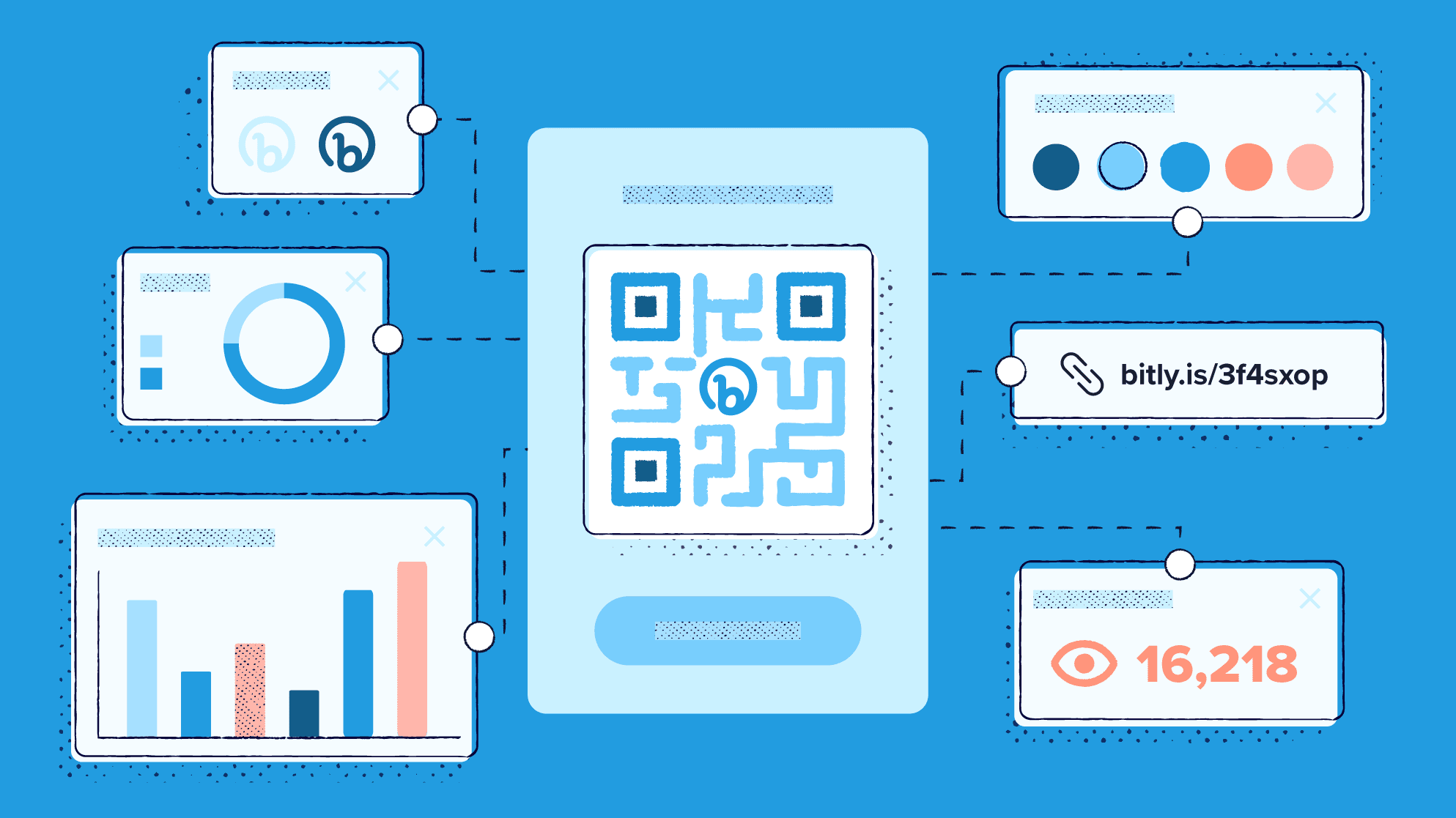
QR Codes have made a major comeback in the past few years. Today’s Dynamic QR Codes enable brands to connect offline experiences with ever-changing online landing pages. Get expert advice on using the flexibility and analytics of Dynamic QR Codes to propel your business.
What is a Dynamic QR Code?
A Dynamic QR Code stores URLs in a printable pattern that a smartphone can read. The Code is Dynamic because you can change the landing page URL without changing the pattern. Customers automatically go to the updated URL when scanning Dynamic Codes on brochures, magazines, products, store displays, or wherever.
All QR (“quick response”) Codes are advanced versions of traditional barcodes that devices can scan more quickly. While traditional barcodes have two-dimensional patterns, QR Codes use matrix barcodes. This means that they can read more data. For example, older barcodes can store around 12 characters, enough to identify a product, while QR Codes can handle more than 4,000 letters, enough to handle tracking data such as device, number of scans, location, time, and more.
Anyone can point a fairly new Android or iOS smartphone camera at a QR Code and rely on the phone to read the URL. The Dynamic Code system will redirect them to the latest website landing page.
The QR Code pattern may look random, but its design enables quick and reliable scanning. The pattern even communicates your orientation so you can scan a QR Code upside down.
Some experts call a Dynamic QR Code an “editable QR code” because you can change the destination URL. These Codes work by sending users to a short-link intermediary that you can change. For example, if you wanted to create a QR Code for https://bitly.com/pages/resources/case-studies, a Dynamic QR Code would assign the destination URL to a short URL, like bit.ly/example. Because short URLs are adjustable, you can always change the destination of the short URL.
Remember, modifying the URL in the Dynamic QR Code does nothing to the QR Code itself. It just changes the assigned URL for the intermediary short link. That means you won’t need to reprint or redistribute the QR Code whenever you want to change a link. You can use link management software like Bitly to create a QR Code, commonly saved as a PNG or SVG file.
Why are QR Codes so popular now?
QR Codes of all types had an unpopular start years ago. Before, smartphones did not have native QR scanning. So, to use a QR Code, users needed to download a third-party app—a hassle large enough to spell stagnation for QR Codes in the United States.
Then, the onset of the COVID-19 pandemic suddenly made QR Codes extremely useful. These QR Codes facilitated contactless menus, signs, and payments, allowing most businesses to keep operating while providing customer safety. Now, both Android and iOS phones come equipped with a native QR scanner in the camera app, so scanning QR Codes is easy. Just point your camera at the QR Code, the link appears, and then tap it to go to the website.
Today, QR Code use cases continue to skyrocket. Bitly’s QR Code trends report shows that in the first half of 2022, there was a 152% growth in QR Code creations compared to the same period one year ago. Experts predict that QR Code scans will reach nearly 100 million users by 2025.
Almost any business and brand can leverage QR Codes to bridge offline and online campaigns and gain key insights into their target audience.
Key takeaways:
- Unlike static URLs, you can change the destination URL of a Dynamic QR Code.
- Dynamic QR Codes come with tracking information absent from Static QR Codes.
- Almost every business can find a great application for Dynamic QR codes, particularly in marketing and promotional material.
- The level of analytic insight you receive from Dynamic QR Codes depends on your QR Code provider.
- Make sure you pair your QR Codes with a compelling call to action (CTA) and that the URL you use in the QR Code is mobile-friendly.
- Free Dynamic QR Codes may limit how often you can change the URL or how long the QR Code remains live. It’s best to use a premium service to create Dynamic QR Codes for long-term use.
What is the difference between Dynamic and Static QR Codes?
The major difference between Dynamic and Static QR codes is that you can change the URL of a Dynamic QR Code after generating the it. In contrast, you cannot change the URL of a Static QR Code as the URL is permanently embedded into the Code’s pattern. If you want to change the URL, you’ll need to create an entirely new QR Code. This means Dynamic QR Codes work best when you anticipate changing your campaign.
This difference may be the starkest between Dynamic and Static QR Codes, but the QR cousins differ in several ways. Here’s a high-level summary of the differences between Static and Dynamic Codes:
- Ability to track data
Once you create a Static QR Code, you cannot track performance or user activity. You won’t know if and how the QR Code is working for you. In contrast, Dynamic QR Code generators enable tracking of data such as the number of scans, devices, and time. Also, unlike Static QR Codes, you can protect a Dynamic QR Code with a password.
- How you direct users to a landing page
Static QR Codes direct customers to a URL that can’t be changed later. However, a Dynamic QR Code uses a short link intermediary that you can adjust anytime. To use a Dynamic QR Code, you need to use link management software to assign and manage your short intermediary URL. In contrast, a Static QR Code will always work unless the destination URL changes or goes offline. - Visuals
Dynamic QR Codes usually feature a less dense pattern than Static QR Codes because they use short URLs. For example, a Dynamic QR Code would automatically shorten the link https://bitly.com/blog/women-employee-resource-group-spotlight/ to http://bit.ly/3RxNVSg. The new link has fewer characters, meaning that the QR Code will need to store a smaller amount of information in its pattern. You can also add images such as icons and logos to the QR Code itself.
Static QR Codes typically require a higher resolution for optimal scanning and therefore may not be appropriate for small-print or low-resolution settings.
Read our article on the differences between Static and Dynamic QR Codes for a deeper discussion.
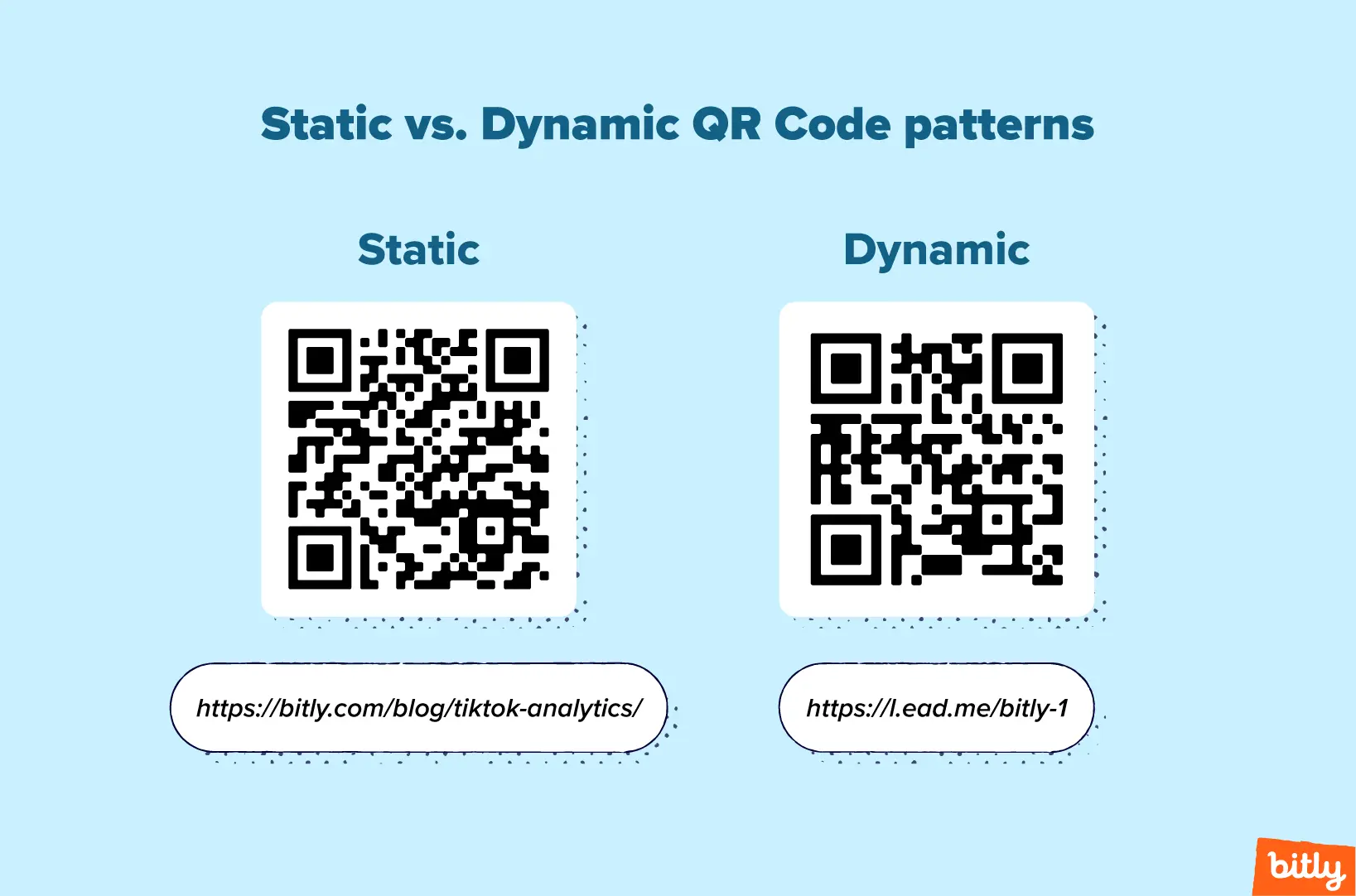
Benefits of Dynamic QR Codes
Dynamic QR Codes give you the flexibility to change the URL in your QR Code at any time. They also offer more design options and analytics, so you know when, where, and how often people scan your Code.
Here are the details of Dynamic QR Code benefits:
- Can update URL in real-time
Accidentally embed a broken URL into your QR Code? Maybe you’ve found a typo in your landing page, or the page itself has become outdated. You won’t have to worry about any of these issues, because you can always update the URL of Dynamic QR Codes in real-time. - More design and use options
With a less dense pattern, Dynamic QR Codes can fit into places that Static QR Codes cannot. You can shrink the QR Code, and your phone will still have no problem understanding where it wants to take you. This smaller size and resolution opens up a world of design options and use cases. - Detailed tracking
Dynamic QR Codes offer analytics like scan location, device, time, and more. This information will help you understand the power of your QR Code and enable you to leverage them more strategically in marketing campaigns. In contrast, Static QR Codes come with no tracking information. - Cost-efficient
Dynamic QR Codes will save you money on packaging material. Many brands use QR Codes on printable material like packaging, receipts, or other items. Because you can change the URL in a Dynamic QR Code at any time, you don’t need to worry about printing and replacing labels with “old” Codes. - Easy to make
With a competent QR software company, you can make QR Codes quickly and easily. Also, some QR companies allow you to make QR Codes at scale.
Disadvantages of Dynamic QR Codes
Dynamic QR Codes have few disadvantages compared with Static QR Codes. Some Dynamic QR Codes vary in cost and analytics, and can only encode URLs without any additional data.
Here’s a deeper look at Dynamic QR Code disadvantages. Note that these limitations also apply to Static QR Codes.
- Can embed URLs, but not other information like phone numbers
Since you can only embed URLs, you’ll want to make sure that the page the QR Code directs to has your contact information. - Relies on an intermediary link
If the link management software you use to create and manage short links closes down, your intermediary link will go offline and people won’t reach your final URL. With Static Codes, the URL could go offline as well. - Reduces accessibility
In general, only individuals with smartphones and an understanding of how to use QR Codes can access them.
Christopher Falvey, co-owner of Unique NOLA Tours in New Orleans, uses QR Codes in promotional material and in the company’s French District headquarters.
Falvey raves about Dynamic QR Codes, but also adds, “We always try to consider how often people actually use QR Codes. We know they’ve been around forever, but they’re not always the go-to way for a customer to get in contact with you. People still need to be educated a little more on using QR Codes when offered them. I really wish there was better adoption in terms of the end user, though it’s definitely not zero.”

Christopher Falvey, co-owner of Unique NOLA Tours.
- The extent of the analytics depends on the QR company
Alexa Allamano, owner of Foamy Wader jewelry and author of The Scan to Shop Solution, uses Dynamic QR Codes as part of window displays in her jewelry store in Washington state.
Though Allamano loves the data associated with the Codes, she also comments, “The data provided is somewhat limited; we can see scans over time and type of device, but those pieces of data aren’t much use to us. Still, because the annual cost is low, Dynamic QR Codes are still worth it for us.”

Alexa Allamano, owner of Foamy Wader.
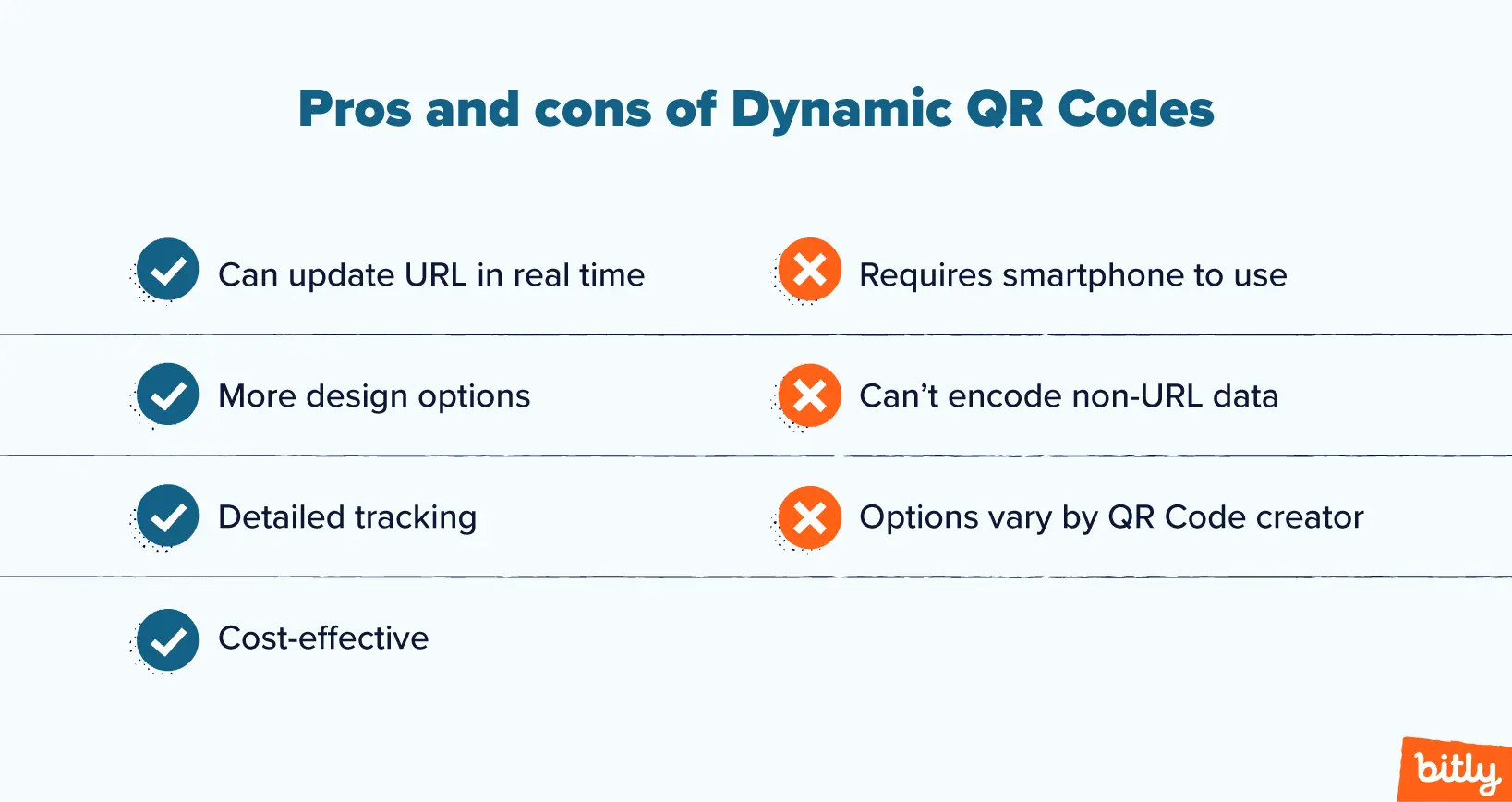
Dynamic QR Code use cases
Companies of all types and sizes have found clever ways to use Dynamic QR Codes to bring people to the desired URL. Businesses that use Dynamic QR Codes include retail, packaging, education, and more.
The use cases for Dynamic QR Codes ultimately include any business that wants to run a marketing campaign and change the landing page. Services whose offerings vary, like restaurants with seasonal menus, also effectively leverage Dynamic QR Codes. Gaming, entertainment, and payment apps use QR Codes to help customers complete contactless transactions. Today, QR Codes have exploded in popularity to become a core marketing tool for many brands.
Here’s a list of some creative Dynamic QR Code use cases:
- Consumer packaged goods
Take a look at the packing of your next purchase, and you will probably find a Dynamic QR Code. The consumer packaged goods (CPG) industry creates merchandise we regularly use, like food, hygiene products, and clothing. QR Codes and product packaging form a natural alliance: With Dynamic Codes, brands can target marketing materials toward the specific audience they believe will purchase a given product, provide more information on their merchandise, or link to particular discounts and campaigns.
Beauty brands use QR Codes on their packaging to connect customers with their websites or unique marketing items directed at a target audience. Nutrition brands use QR Codes on their nutritional supplements to lead viewers to educational material about their products—with a Dynamic QR Code, they can change the content but not have to print a new label. Additionally, some clothing companies include QR Codes on merchandise that give detailed instructions on how to wash or care for a product. - Retail
Alexa Allemano uses scannable QR Codes in her storefront windows at Foamy Wader. “Shoppers use their smartphone camera to scan the QR Code next to an item in the window, leading them to order that exact item on my website,” she says. “I also use QR Codes to feature mini-collections, capture new email subscribers and social media followers, and book appointments.”
Allamano has seen direct results from her QR Code campaign. “The added benefit of this omnichannel approach has been an increase in both my online and in-store average order value (AOV) of 10 percent and 19 percent, respectively. The business has surpassed pre-pandemic levels and we recently expanded into a second larger showroom.”
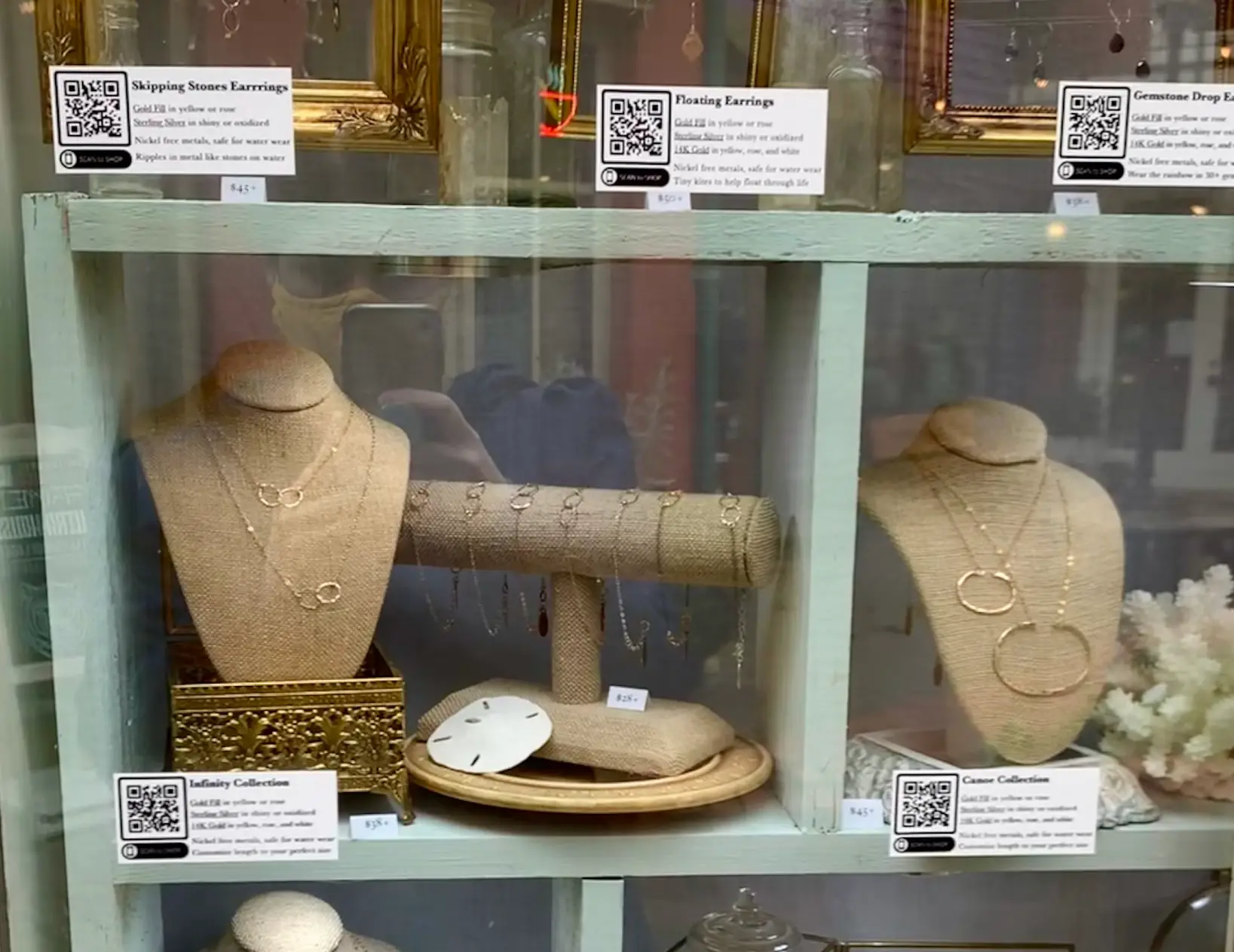
- Entertainment
Television and film company Marvel Studios incorporates QR Codes into in-person marketing events like Comic-Con. While fans wait for actor appearances at the Marvel booth, they can scan the QR Code to download Marvel’s comic book or buy other items.
You also may notice QR Codes in episodes of the Marvel series “Moon Knight.” Fans who find the semi-hidden QR Codes can quickly pause the episode, scan the code, and visit a website that contains a webcomic featuring the new characters. This strategy gives viewers a reward for spotting the Dynamic Codes, and Marvel can change the URL destination for each episode. In addition, it increases their knowledge of the rather obscure Moon Knight comic, boosting customer loyalty and brand engagement. The QR Codes have proven their worth to Marvel. According to Disney, the Marvel QR Code has registered over 1.5 million visits to their landing page and over 500,000 downloads of the Moon Knight bonus comic book. - Education
Many booksellers use QR Codes in their ebooks to market new releases or direct readers to educational material. Paki Perkins, an author, speaker, and co-owner of Perks Publishing, uses Dynamic QR Codes in his company’s marketing material.
“Because we can change where the Code is directed to, we save money by not having to print different fliers or material every time we want to promote something new,” Perkins explains. “We also put QR Codes inside our book and change the call to action.”

Paki Perkins, co-owner of Perks Publishing.
Perkins also describes other ways his publishing company takes advantage of Dynamic QR Codes. “For marketing, we use a QR Code for each book launch location that we change as each date nears. We also have a QR Code that we have for each author, which we customize based on the audience. Finally, we include QR Codes inside our print and digital books. These links direct toward learning courses that readers can sign up for. If the courses change, we can update the link without anyone knowing.”
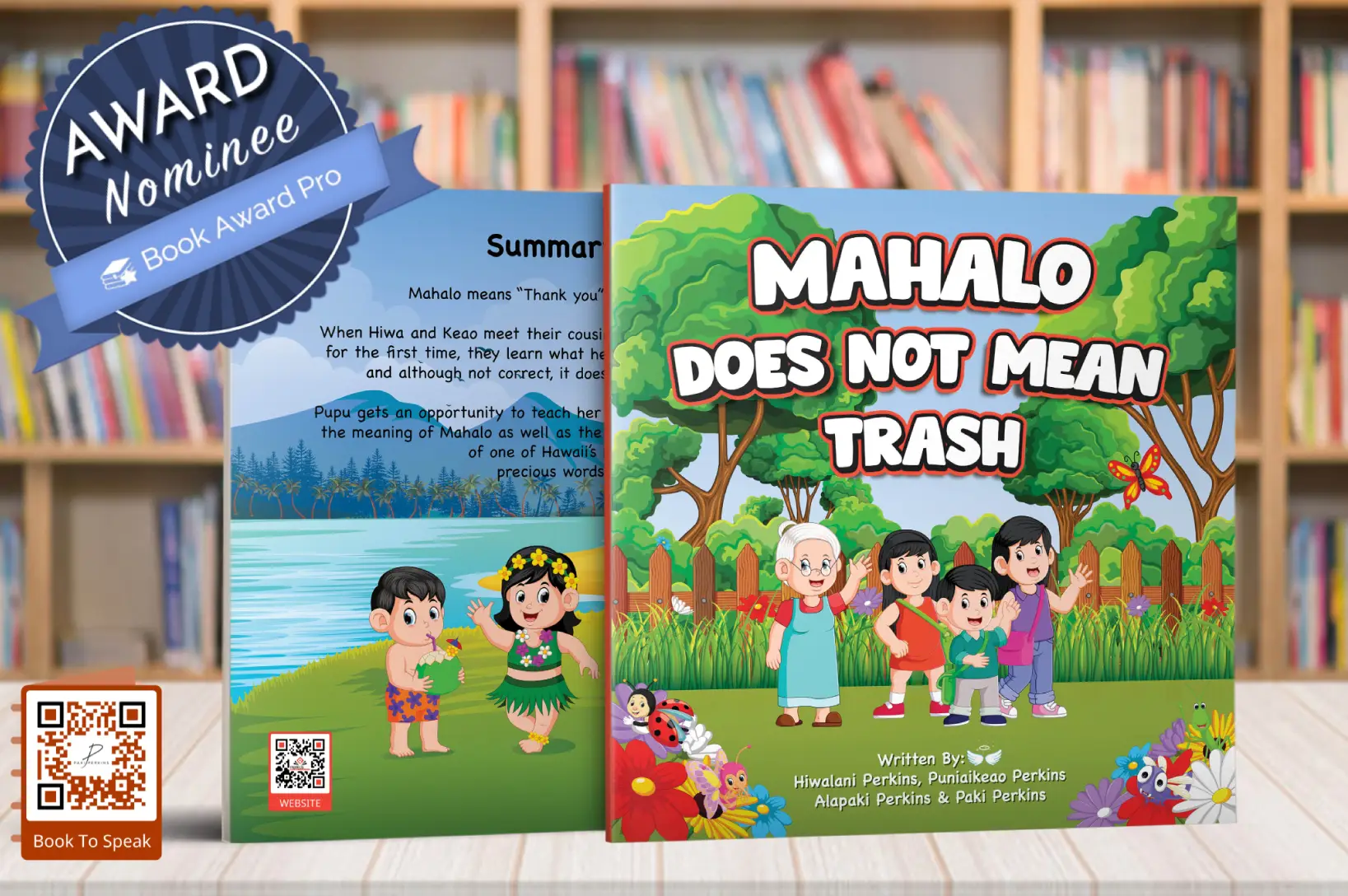
- Publishing
Book publisher Regency Reads uses Dynamic QR Codes at the back of their ebooks to market new releases, integrating the book cover for enhanced marketing.
The current QR Code may take the reader to a preview of the book on Amazon, but Regency Reads can change the URL destination to other sites like Kobo, Apple iBooks, Barnes and Noble, Google Books, Scribd, or Regency Read’s home page. In some cases, the company customizes the link so it matches the original site where the customer bought the book. When the audiobook comes out, Regency Reads simply reprograms all links to direct to the audiobook version.

- Hospitality and tourism
Tour company Unique NOLA tours, a ghost tour company in New Orleans, uses QR Codes in its storefront and printed material.
Co-owner Christopher Falvey points out, “Tourism-based industries, like our company, have seasonal campaigns which often are associated with new (and sometimes temporary) URLs. With Dynamic QR codes, we can direct old printed QR codes, on brochures, for example, to new URLs. That way, an older brochure that found its way to a potential customer can still direct them to new URLs when we want to highlight special events and tours that are more recent than the print date of our physical marketing assets.”
Falvey continues, describing another way he uses QR Codes. “We have a storefront in the popular French Quarter district that sees regular foot traffic, 24/7. Because we can only maintain certain business hours, we provide a QR Code right on our window that sends people to a link where they can book a variety of tours, equipped with all the UTM keys that Google needs to track our clicks. Now, when our signage changes—based on a holiday, for example—we change the destination URL.”
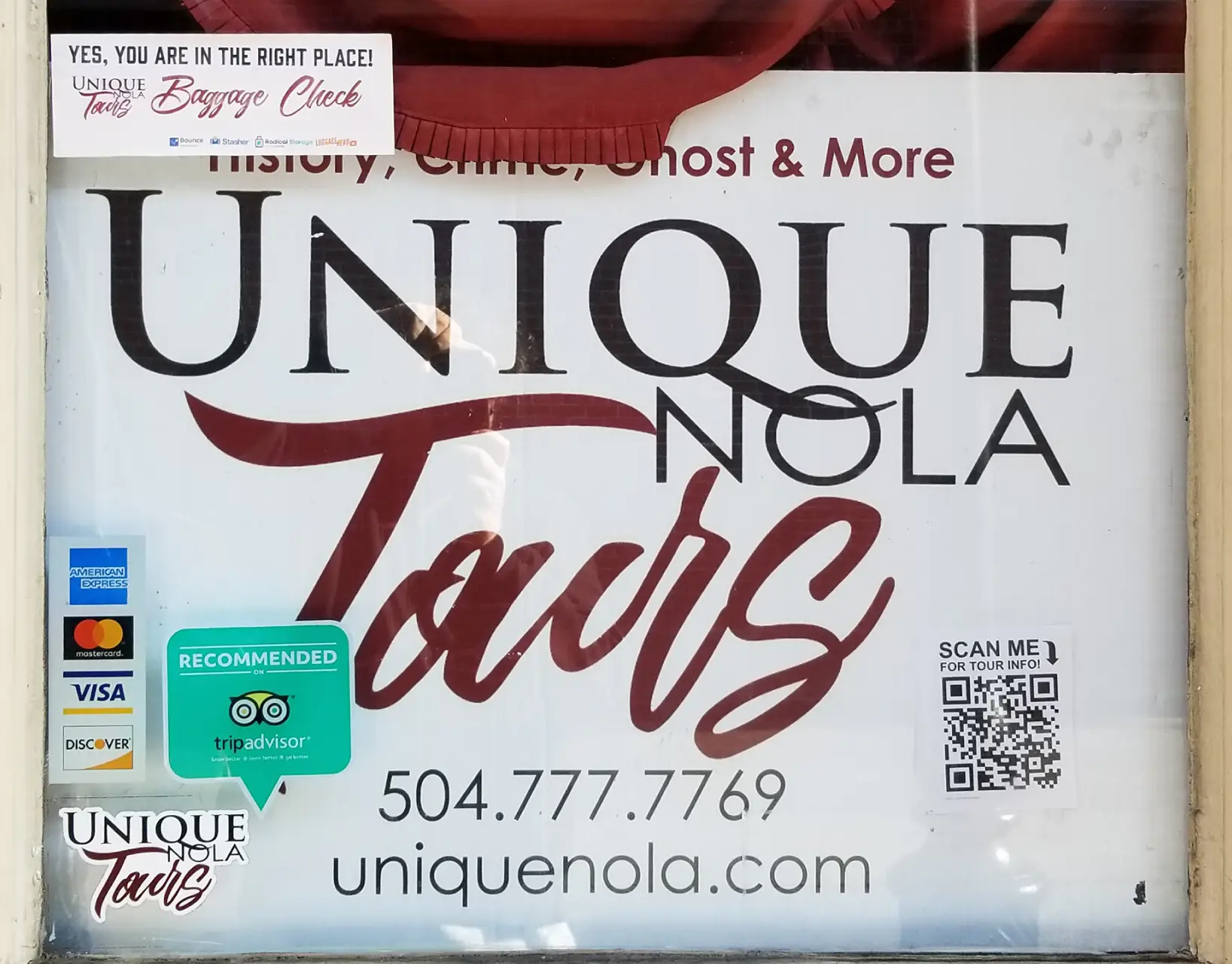
- Trade shows and promotional events
Dynamic QR Codes come in handy on posters and other marketing material that businesses use in trade shows and promotional events. Because they can change the link, brands can use the same posters at different events, with a different destination URL targeted to a specific place or audience.
For example, at Bitly’s trade show booths, they can set the destination to “BitlyCares—Advertising Week New York 2022.” Once Bitly takes the show elsewhere, they can build a new landing page and change the destination URL—but they won’t have to reprint the Code.
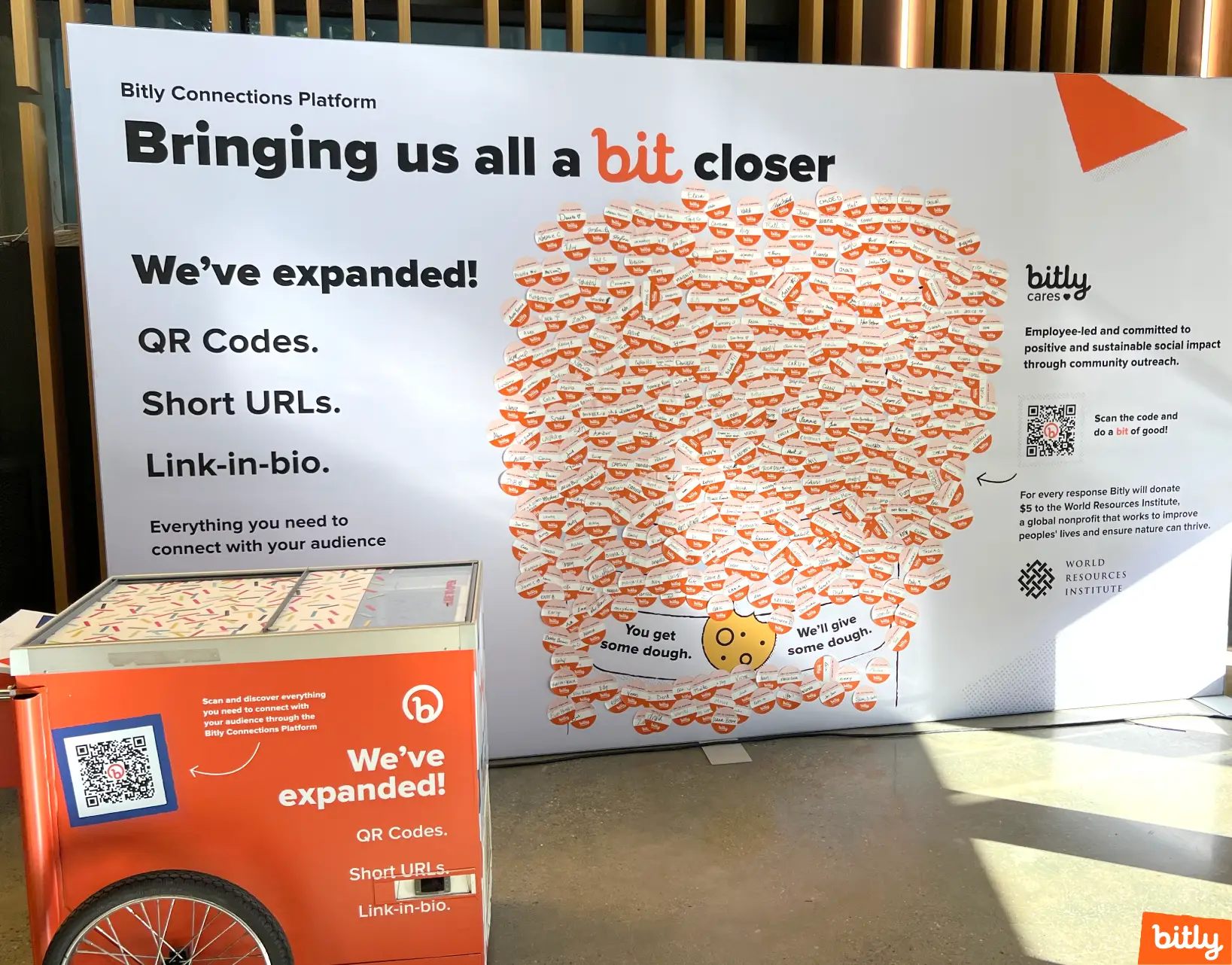
- Restaurants
QR Codes reinvented the traditional menu, particularly during the height of the pandemic. Restaurant owners wanted to minimize interactions, so instead of printing menus, they placed QR Codes on tables that lead to a menu.
Even as pandemic concerns have lessened, many restaurants have kept their QR Code menus to capitalize on certain benefits. For example, Dynamic Codes help restaurants update seasonal menus, or add and remove items without having to spend money and resources on printing new physical copies.
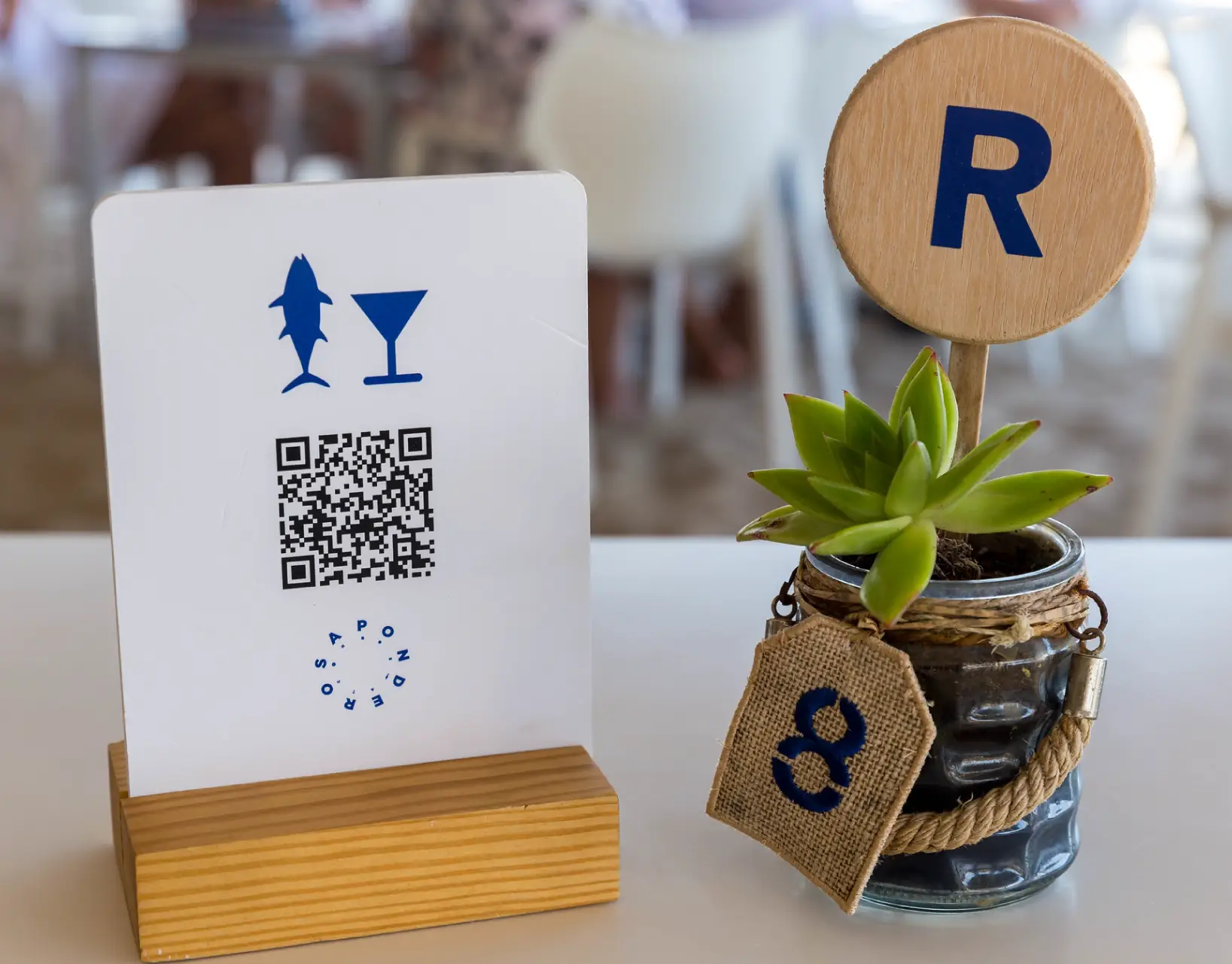
Expert tips on using Dynamic QR Codes
You can use Dynamic QR Codes in diverse applications and settings. To get the most out of your Codes, follow expert tips like adding a compelling call to action or placing the Code prominently in marketing material.
Here are actionable tips straight from Dynamic QR Code pros:
- Double-check sizing requirements
CEO Barbara Casey from Mobile High 5, an SMS Marketing Agency, uses “QR Codes as one of the ways we opt folks into a text program. Our QR Codes automatically open the messaging app and automatically insert the campaign keyword and the client’s specially provisioned phone number. All the subscriber has to do is press send.”
Casey’s top tip: “Make sure that the resolution is appropriate for the size you will be using them.”
- Add a compelling call to action (CTA)
Allamano, the owner of Foamy Wader jewelry store, understands that not everyone immediately knows how to use a QR Code. Allamano uses a call to action to communicate simple instructions.
“As the public is still becoming aware of QR codes, providing a CTA is important,” Allamano says. “A simple ‘scan to order’ gets the point across clearly. “ - Use prominent placement in marketing materials
“Work some magic around the QR Code to entice people to actually use it,” stresses Falvey, co-owner of Unique NOLA Tours. “Chances are you’ve also offered what appears to be more friction-free ways of contacting you (your core URL in print, a phone number). Give people a reason to scan the Code!”
You can use smart wording, as Falvey suggests, and also place your QR Code in obvious, prominent spots across your marketing material. Don’t hide it in the corner of your brochure. - Make sure the Code leads to a mobile-friendly site
Remember, everyone uses a smartphone to scan codes, so the URL will appear on the phone, not a computer. Optimize your destination URL for mobile viewing to make the experience easy for your customers. For example, imagine a restaurant linked to a normal PDF of a menu. Many consumers would give up as they tried to scan and scroll through the various options.
- For printed QR Codes, consider the surface material
Make sure your QR Codes print onto scannable, visible surfaces. Don’t print Codes onto something that will be blurry, or a surface that can become distorted easily. A QR Code that a user cannot scan is effectively rendered useless. - Incorporate design elements like branding
Perkins, co-founder of Perks publishing, uses Bitly to create QR Codes. Perkins comments that he and his children, who are also co-owners, “like the fact that you can customize them to match your branding.”
These additional design elements help Perkins’ writers and graphic designers. “Our writers and designers keep the QR Code in mind as they design the assets we use. We are also trying out the different types of Codes available. In my opinion, the ability to customize our QR Codes with our logo sets them apart from other ones on the market. If you’re thoughtful, you can easily integrate QR Codes into your overall branding and marketing.”
- Have a QR Code marketing and distribution plan
Treat your QR Code like any other important marketing asset and release them based on a distribution plan. You can use your tracking and analytics to develop and fine-tune your marketing. - Test your Code
This tip is simple yet crucial: Before you publish your Code, scan it to make sure it works.
What you can track with Dynamic QR Codes
You can use tracking tools in your QR Code software to see analytics about your Dynamic QR Code. Depending on the software you use to create the QR code, you’ll be able to view data like scans by location, device, and time. Use that data to determine the ROI for your efforts.
Many services are available for creating a Dynamic QR Code—some of them are free, and others require a fee. Free services don’t always allow you to track data for your Dynamic QR Code. They can also limit how many times you can change the URL in the Dynamic QR Code or how long the QR Code will remain active. Premium services remove these limitations and are worth the investment for people who want to use their Dynamic QR Code long-term.
Here’s a list of the type of data you can track with a Dynamic QR Code:
- Time period
You can track the day, month, and time someone scanned your QR Code. In some QR Code tracking software, you can adjust the data to show a given period. This data will help you see a campaign’s success over a specific period. - Type of device or operating system
This data tells you what smartphone (Android, iOS, Windows) a person used to scan the QR Code. This information will let you know more about your users and adjust accordingly. For example, if you’re an app company and the majority of your scans originate from an Android phone, you can change the Dynamic QR Code to open your app on the Google Android store. - Location
This data is often broken down by city and country. Use this information to learn more about areas that deliver the most engagement and adjust your marketing efforts accordingly. - Unique scans
This number represents how many times a device scanned your QR Code. Tracking software tends to use an IP address to log a scan. So if the same device scans a QR Code multiple times, it would only be counted as a unique user once. That said, the total amount of times they used the device to scan the QR Code will be counted in the total scans. - Total scans
Use this data to learn about the effectiveness of your QR Code. This number represents how often the QR Code was scanned regardless of the device. So someone could have used their phone to scan the Dynamic QR Code more than once.
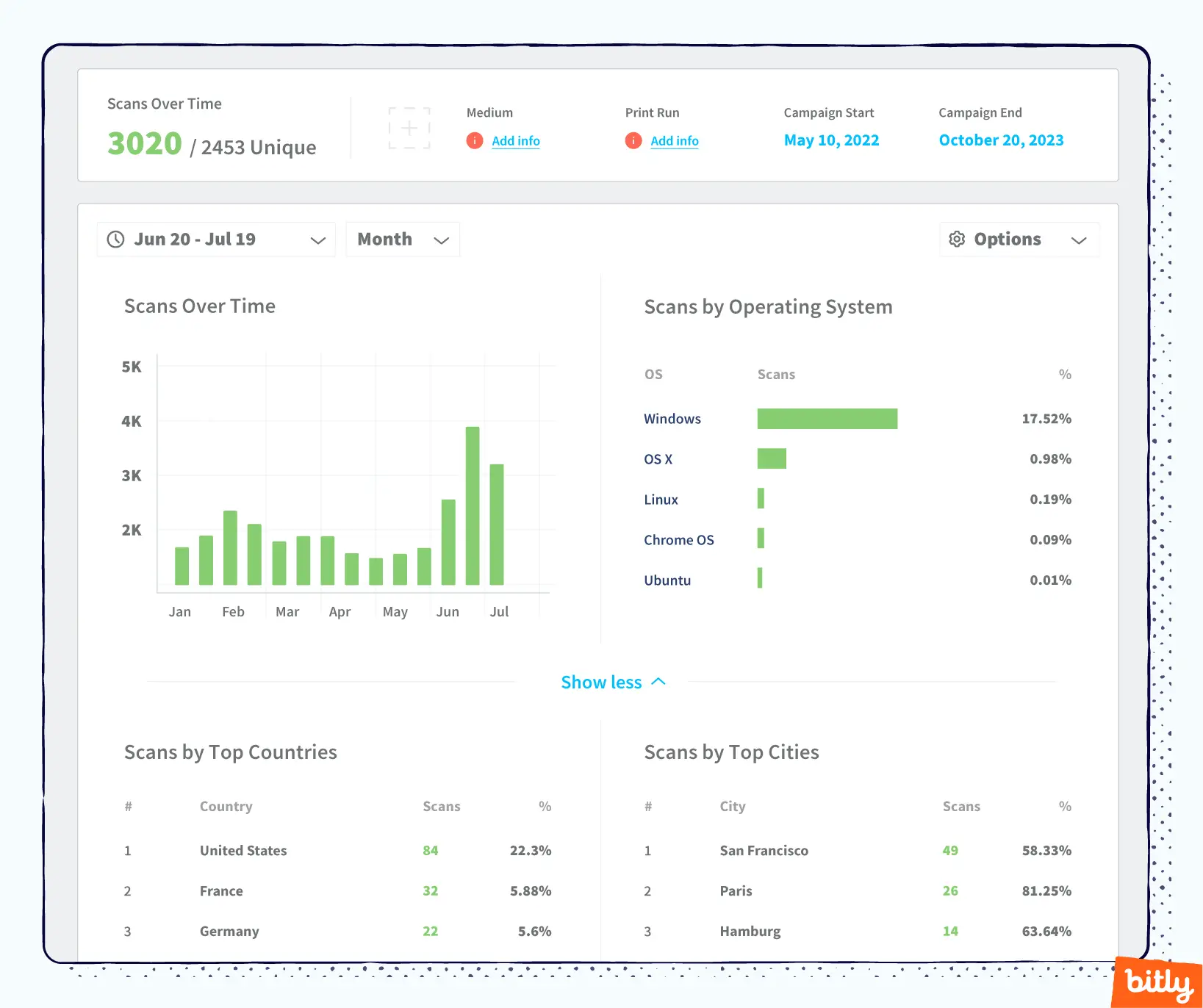
How to create a Dynamic QR Code
You’ll need to use QR Code software to create a Dynamic QR Code. These online services are fairly straightforward. You’ll need to determine where you want the QR Code to point people and create a shortened URL that you’ll embed in the Code.
First, sign up with a QR Code service that provides Dynamic QR Codes. Then, use their software to create Dynamic QR Codes whose URLs you can always change. Some premium QR Code solutions allow you to customize the QR code’s shape, size, and color. You can also use the online tool to add an image, such as a logo or icon, to the Dynamic QR Code. The QR Code will appear on the screen when you finish creating it. Test it by scanning the Code with your phone. Then, you can download or customize it. You can also return to it at another time and edit it to replace the destination URL.
Why you should use Bitly Dynamic QR Codes
Bitly added QR Codes to its classic, popular platform. In the Bitly Connections Platform, you can create, customize, track, and edit your Dynamic QR Codes within a single Dashboard. Plus, Bitly’s product, QR Code Generator, adds advanced features like customizable shapes and frames.
“The QR Code company you choose to align with could easily make or break your QR campaigns,” notes Bitly President Raleigh Harbour. “Partnering with Bitly, the trusted leader in link management, gives you access to a one-stop platform and Dashboard to manage and track all of your online and offline connections. We have joined forces with QR Code Generator, the leading QR Code platform, to give our customers access to the best QR Code options on the market today.”
Bitly offers several QR Code solutions, including Dynamic QR Codes with customizable logos, colors, and frames fit for any need and industry. For example, on the intuitive QR Code Generator Dashboard, you’ll see a quick summary of all of your analytics like the time of the scan, location, and device. Join Bitly’s diverse clients, from small business owners to major corporations, to connect your customer’s offline life with your online experience.
Dynamic QR Code FAQs
Find answers to frequently asked questions about Dynamic QR codes, like whether the QR Codes expire and how to change the URL of your Codes. Also, find advice on when to use a Static vs. a Dynamic QR Code.
- Should I use a Dynamic or Static QR Code?
Use a Dynamic QR Code whenever you think you might change the destination URL, such as for season-specific campaigns or events. Also, use a Dynamic Code whenever you want to track scans.
In general, Dynamic QR Codes offer everything that a Static QR Code does, plus flexibility and tracking. However, if you know your link will never change, and you won’t find analytics useful, a static QR Code is more cost-effective. - Are Dynamic QR Codes free?
You can find QR Code generators that offer free Dynamic Codes. However, these Codes often don’t come with analytics or customizable design options, and they can have limitations on use and longevity. - How much does a Dynamic QR Code cost?
The cost to create a Dynamic QR Code varies based on your QR generator service and how many Codes you want to create. The price also depends on whether you select features like customizable design and analytics.
Generally, experts consider Dynamic QR Codes, with analytics and design, to be cost-effective. The price can range from free to $200 per month or more, depending on the features you select and how many Codes you want to create. Also, many link management platforms bundle the cost of a Dynamic QR Code within their other services, like a link-in-bio tool or branded URLs. - Are Dynamic QR Codes safe?
Experts consider Dynamic QR Codes to be very safe because no one can hack into the Code without changing its pixelated pattern, rendering it unreadable. Any security risks are related to ways that hackers can break into the destination URL.
It is possible to scan a QR Code that leads to a malicious website. However, QR Codes that have been tampered with usually look the part. Always double-check that QR Codes look original and that the design matches the company’s material. Also, exercise other internet safety practices like immediately exiting any website that asks for personal information. - How do I change the URL on a Dynamic QR Code?
Every QR generator has a different system in place designed for users to change the URL. Log in to your QR generator and click on the Dynamic QR Code you want to change. In general, the steps to edit the Code should be straightforward. - Do Dynamic QR Codes expire?
Dynamic QR Codes do not have expiration dates. If the URL within the Code is active, the QR Code will function. A Code can become unscannable if something disrupts its pattern. For example, if the printed material is wet, the QR Code will likely distort.